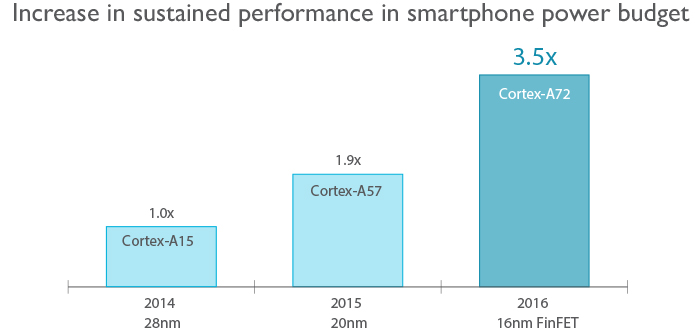Cortex A72-Powered Snapdragon 618, 620 Renamed To Snapdragon 650, 652
Qualcomm announced that its mid-range chips for next year, the Snapdragon 618 and Snapdragon 620, will be renamed the Snapdragon 650 and Snapdragon 652, respectively, to better represent the jump in performance over the Snapdragon 615, 616 and 617.
Whereas the Snapdragon 615 came with Cortex-A53 CPU cores (the same ones in the lower-end Snapdragon 410 chip, but at a higher clock rate), the new Snapdragon 650 and 652 will bring ARM’s latest Cortex-A72 CPU core.
The new CPU core is ARM’s highest-end CPU design and a direct successor to Cortex-A15 and Cortex-A72. According to the company, the Cortex-A72 is 3.5x faster on a 16nm FinFET process than the Cortex-A15 was on a 28nm process, and 1.9x faster than the Cortex-A57 built on 20nm.
Despite this large performance improvement over the Cortex-A57, which was in this year’s highest-end chips (and even caused some overheating issues in 20nm chips), Qualcomm is still going to use it in its mid-range SoCs, such as the Snapdragon 650 and Snapdragon 652, for next year. That’s because Qualcomm must believe (or know) that its Kryo cores that will be inside its flagship chip, the Snapdragon 820, are even faster.
According to Qualcomm, the Snapdragon 650 and 652 chips have seen quite high demand from device makers so far. This could be because the two chips have, for the first time in this tier, 4k video capture and playback support, as well as strong gaming capabilities thanks to the next-generation Adreno 510 GPU. The chips also come integrated with Qualcomm’s X8 LTE generation, which brings Cat. 6 LTE speeds and carrier aggregation support.
The good news here is that chips such as Snapdragon 650 and 652 should bring to mid-range devices some features and performance that equal or surpass even this year’s high-end chips. Qualcomm’s Snapdragon 810 controversy from this year must have made the company want to do much better next year, and so far it shows, at least on paper.
It still remains to be seen how these chips will actually perform in devices. Qualcomm should certainly be much more careful about prioritizing performance over power consumption and thermal management this time, unless it wants to risk another controversy and loss of sales next year.
Get Tom's Hardware's best news and in-depth reviews, straight to your inbox.
______________________________________________________________________
Lucian Armasu joined Tom’s Hardware in early 2014. He writes news stories on mobile, chipsets, security, privacy, and anything else that might be of interest to him from the technology world. Outside of Tom’s Hardware, he dreams of becoming an entrepreneur.
You can follow him at @lucian_armasu. Follow us on Facebook, Google+, RSS, Twitter and YouTube.
Lucian Armasu is a Contributing Writer for Tom's Hardware US. He covers software news and the issues surrounding privacy and security.
-
bit_user According to another news site (gsmarena), the 650 core config will be: 4x A53 + 2x A72. The 652 core config will be: 4x A53 + 4x A72. A72's to be clocked at 1.8 GHz and A53's clocked at 1.2. Seems kinda low, for the A72's, but then I guess Qualcomm needs to leave a gap between that and their Kryo-based SoCs. Also, might let OEMs use smaller batteries.Reply
I wonder if anyone will pair A35's with A72's, of if they're in too far different performance leagues.
Also, I don't understand the 4+2 pairings, which Qualcomm has also done in previous Snapdragons. Is there much benefit over 2+2, or is it just done that way for manufacturing or marketing reasons?
-
Marius Cirsta ReplyAlso, I don't understand the 4+2 pairings, which Qualcomm has also done in previous Snapdragons. Is there much benefit over 2+2, or is it just done that way for manufacturing or marketing reasons?
Well you have to remember that the 4 are A53s or maybe A35s in the future. These are very small, low power cores. They don't take much space on the chip ( not much increase in cost ) and also don't use a lot of power so 2 more of these isn't really an issue.
It gives you a nicer figure for marketing ( 6 cores vs 2 ) and is theory well optimized apps could be made to limit themselves to these 4 low power cores. Given the number of processes running in the background that shouldn't need lots of compute power this makes sense, 4 of these will limit the usage of those high power A72 that you probably want to keep idle and not using power.
This of course all depends on the quality of your apps and scheduler but anyway 2 A53s cores are really cheap these days. -
bit_user Reply
Thanks, but I didn't mean 6 vs. 2, I meant 6 (2+4) vs. 4 (2+2). It seems to me that, for a few apps & OS functions running in the background, 2x A53's should be plenty. I wonder how often more than two A53's are used while both A57's remain idle. Anyway, I just now read, in the 820 Preview article, that the 820 is exactly this - 2 fast cores and 2 slow ones. But, in that case, the slow Kryo's probably cost the same amount of die (except for L2 cache).17147092 said:It gives you a nicer figure for marketing ( 6 cores vs 2 )
My guess is that the 4+2 chips are binned parts where at least one of the faster cores has a defect. Because they're so small, it's probably much less common that the A53's have a defect. Then, the reason they don't disable 2x A53's is because it wouldn't cost them anything and they could sell it as a 6-core instead of 4-core.
Something else I've been wondering is whether the latest Android kernels can simultaneously utilize all cores. I remember when the first BIG.Little SoCs hit the market, the two clusters were mutually exclusive. I think it wouldn't be too hard to schedule - just throw something on a low power core if the high power ones are occupied. Beyond that, CPU-bound jobs (i.e. those which use the most % of their timeslices) should have priority for running on the fast cores. That way, most of the I/O would end up on the slow cores, leaving the fast ones available for number crunching.
-
Marius Cirsta I just wanted to say that I'm not sure if the 6 cores are 8 cores with 2 disabled, they could be but it depends on how many are needed. If there's a lot of demand for 6 cores then it makes sense to produce them separately.Reply
Anyways 4 A53s still make sens because you can have the cores remain in their low frequency range if everything goes OK.
Today's SOCs cand indeed use all their 8 or 6 or whatever cores at the same time but they I doubt they can run like that for a long time because of thermal issue. They can still run on all 8 cores enough to get a good Antutu score though :) -
bit_user Reply
Thanks for the info. I guess one advantage of Apple's approach is simplified thread scheduling. If you have only two identical cores, then there's no risk of putting a big job on a little core.17148531 said:...


